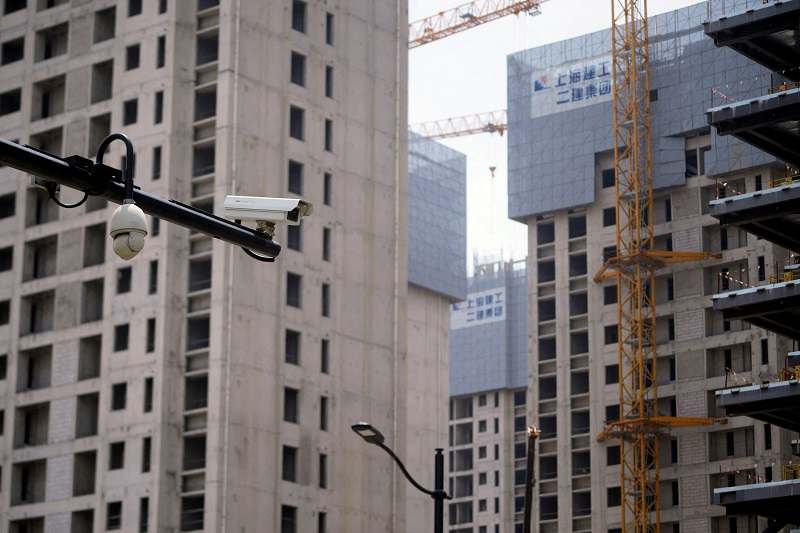
Surveillance cameras are seen near residential buildings under construction in Shanghai on July 20.
17:17 JST, September 26, 2022
PHNOM PENH (Thomson Reuters Foundation) — The drones were hard to avoid: they buzzed low over the crowd of protesters holding banners and shouting slogans outside the NagaWorld casino in the Cambodian city of Phnom Penh, then hovered above each of the speakers as they called for justice.
As hundreds of workers went on strike outside the glass and chrome towers of the firm’s hotel and casino complex, demanding the reinstatement of nearly 400 employees who were laid off last year, armed riot police and surveillance cameras kept watch.
“We knew we were being recorded, but we couldn’t do anything, so we would wave at the drones,” said Chhim Sithar, 34, a union leader who was arrested at the January protest along with more than a dozen others and held in jail for nine weeks.
Hong Kong-listed NagaCorp said the strike that began in December was illegal, and that the layoffs were a “mutual separation plan” to cut costs during the COVID-19 pandemic.
Municipal police have said the workers’ strike was illegal and a threat to public order and safety. Police charged some protesters with “incitement to cause serious chaos to social security.”
Chhim Sithar and other Cambodian rights activists say they are under constant surveillance, their every move online and offline tracked by software, cameras and drones.
Much of the technology is supplied by China, which sells extensive digital surveillance packages to governments under its Belt and Road Initiative (BRI) infrastructure project.
Chinese President Xi Jinping launched BRI in 2013, aiming to harness China’s strengths in financing and infrastructure construction to “build a broad community of shared interests” across Asia, Africa and Latin America.
China has installed more than 1,000 CCTV cameras in Phnom Penh as part of a new nationwide surveillance system, according to local media reports.
Cambodian government spokesman Phay Siphan denied that the technologies are used to target activists and union leaders.
“The CCTVs and other surveillance infrastructure are for security purposes, to fight crime, and traffic violations and other illegal actions,” he told the Thomson Reuters Foundation.
While authorities justify surveillance on security grounds, human rights groups have raised concerns about privacy violations and the potential for profiling and discrimination, with the technologies often deployed without public consultation, and in the absence of strong data protection laws.
Countries taking part in BRI are using technologies including artificial intelligence-based facial recognition systems linked to abuse of minority Uighurs in China for smart policing or smart cities programs, and digital tools for monitoring social media sites.
“These tools offer new possibilities for tracking and intimidating dissenters, monitoring political opponents and preempting challenges to the government,” said Steven Feldstein, a senior fellow at the Carnegie Endowment for International Peace (CEIP), a think tank based in Washington, D.C.
“In authoritarian settings, these capabilities have obvious potential to deepen repression,” said Feldstein, who estimates that Chinese AI surveillance technologies are being rolled out in more than 50 BRI countries.
A key part of China’s BRI program is the so-called Digital Silk Road — an initiative that aims to build modern telecom and data infrastructure among nations lying on the ancient Silk Road trade route.
Chinese involvement ranges from its tech firms building submarine internet cables, data centres and mobile towers, to nations copying its cyber laws and internet gateways to control the flow of data and information, said a recent report by the Alliance to Secure Democracy (ASD), a U.S.-based think tank.
“There is a risk that the Chinese state may be able to amass data — whether it’s genetic surveillance information or more traditional information about political opinions or activity through these systems,” said Lindsay Gorman, senior fellow for emerging technologies at ASD.
“There is a real question about where the data that fuels these surveillance systems is stored, who owns it and who benefits from it,” she said.
The Chinese Embassy in Cambodia could not be reached for comment. Chinese authorities have said tech monitoring is vital to combat crime and prevent the spread of COVID-19, and has denied reports that it is using tech to enable abuse of Uighurs.
‘We are all afraid’
In Myanmar, where the military overthrew an elected government last year and launched a bloody crackdown on protests and dissent, Chinese firms are deploying 4G and 5G networks, as well as facial recognition systems in several cities.
The junta has adopted cyber laws that echo China’s — including limiting internet access to certain websites, and banning social media platforms such as Facebook and Twitter.
A spokesperson for the junta did not respond to a request for comment. Officials have earlier said that facial recognition systems are needed to maintain security and “civil peace.”
But reports of the use of CCTV and facial recognition to target protesters have made Hsu, a lawyer who provides legal aid to political prisoners in the city of Mandalay, “more afraid.”
“The police submit CCTV records as evidence in the court, so we know it is dangerous for the activists,” said Hsu, 26, using a pseudonym for fear of reprisal.
“When I went to prison to meet with jailed activists, I would wear a mask — not because I was scared of COVID-19, but because I wanted to hide my face.
“We are all afraid of the CCTV.”
Being watched
Worldwide, the rise of AI technologies have led to the proliferation of mass surveillance systems, including face recognition and voice identification for a range of uses, from tracking criminals to marking student attendance.
“Technology has changed the nature of how governments carry out surveillance and what they choose to monitor,” said Feldstein.
In Cambodia, where authorities are building a national internet gateway — similar to China’s internet firewall that blocks websites and social media platforms — there is little transparency around these systems, said Chak Sopheap at the Cambodian Center for Human Rights, a nonprofit.
“The government has disclosed no information as to the data gathered, and how they are used by the authorities. This lack of transparency is highly problematic,” she said.
“The use of such technologies affects the right to privacy of people, especially those who do not support the government, and provides Cambodian authorities with an additional tool to crack down on critical voices and dissidents.”
In Phnom Penh, labour leader Chhim Sithar and her fellow protesters are adapting: they do more in-person meetings, where they turn off their phones, they use virtual private networks (VPNs) and encrypted chat groups and refrain from posting on social media.
“This feeling of being watched and tracked all the time is exhausting,” she said.
“We cannot do anything without the police knowing — it’s scary.”
"World" POPULAR ARTICLE
-

8 Japanese Nationals Stranded on Indonesia’s Sumatra Island
-

Mozambican Cooking Class Held in Matsuyama, Ehime Pref.; Participants Don Aprons, Bandanas Made from Traditional Mozambique Fabric
-

China to Impose Sanctions on Shigeru Iwasaki, Former Head of Japan’s Self-Defense Forces, Who Serves as Adviser to Taiwan’s Executive Branch
-

China Steps Up ‘Wolf Warrior’ Diplomacy Against Japan, Hurling Accusation About Plutonium Stockpile
-

U.S. Senate Resolution Backs Japan, Condemns China’s Pressure
JN ACCESS RANKING
-

Keidanren Chairman Yoshinobu Tsutsui Visits Kashiwazaki-Kariwa Nuclear Power Plant; Inspects New Emergency Safety System
-

Imports of Rare Earths from China Facing Delays, May Be Caused by Deterioration of Japan-China Relations
-

University of Tokyo Professor Discusses Japanese Economic Security in Interview Ahead of Forum
-

Japan Pulls out of Vietnam Nuclear Project, Complicating Hanoi’s Power Plans
-

Govt Aims to Expand NISA Program Lineup, Abolish Age Restriction






















